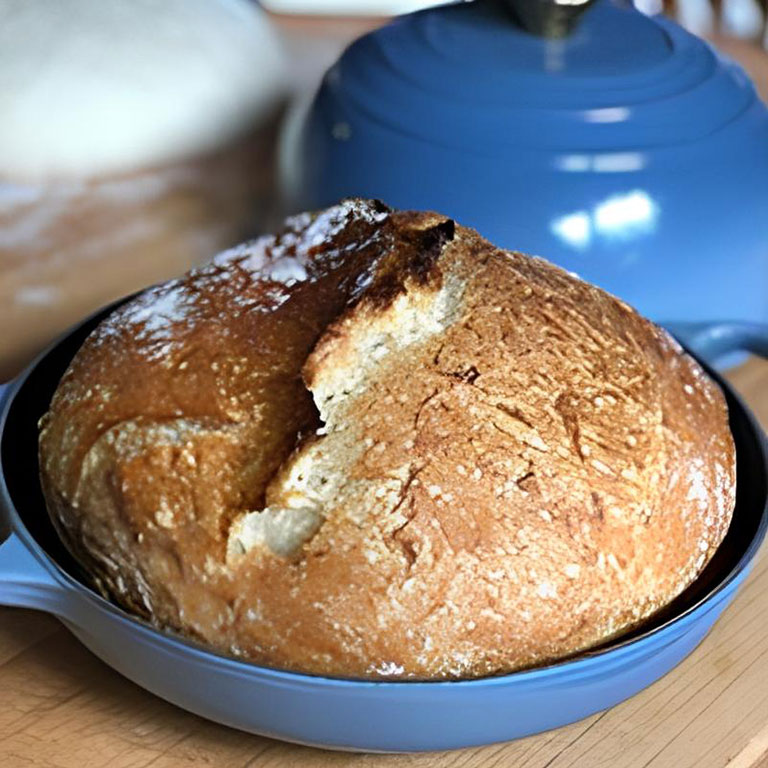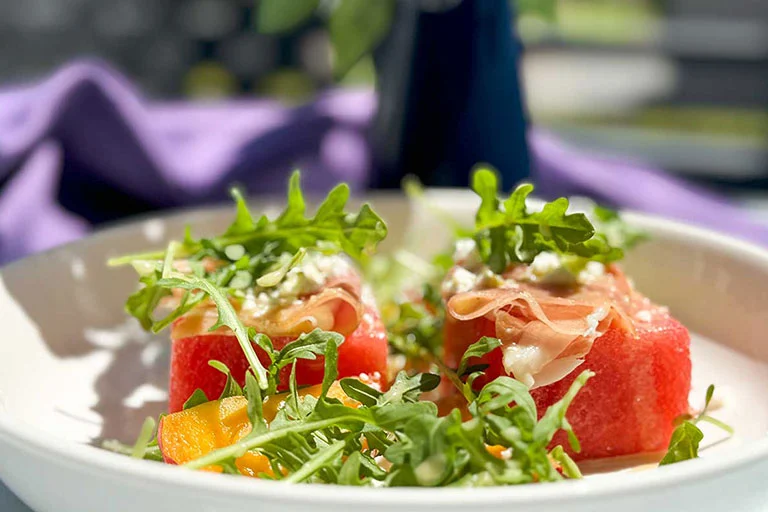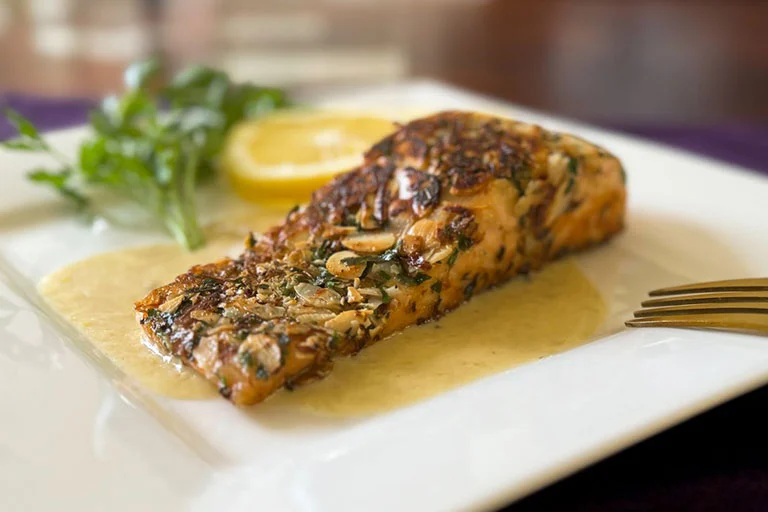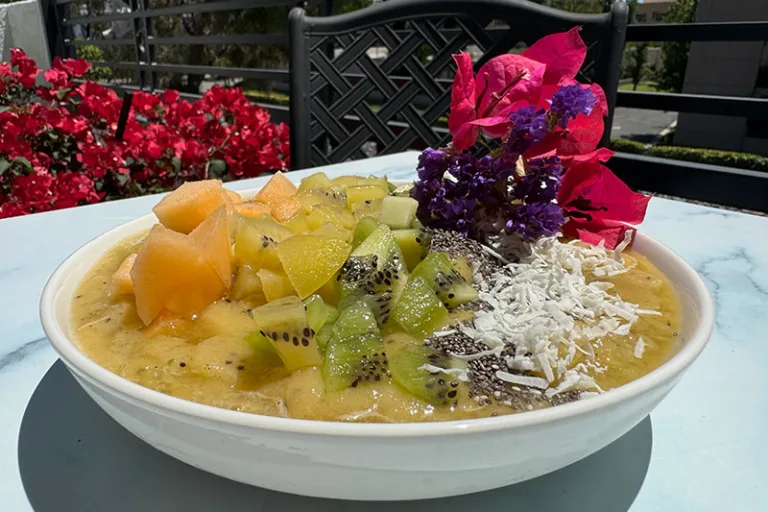
My Curated Tastes is reader-supported. When you buy through links on our site, we may earn an affiliate commission at no extra cost to you. As an Amazon Associate I earn from qualifying purchases.
My hami melon and kiwi smoothie bowl takes advantage of an often-overlooked Chinese melon known as the hami melon. This is one lite and refreshing bowl that gets topped with some healthy seeds and a little bit of unsweetened coconut for texture. It is beautiful to look at and so delish! I was only recently introduced to this melon by a friend, Mona, who is always bringing me new fruits to try. Last week it was a golden kiwi (yup, I used those in this recipe too!) and this week, it was the hami. She’s like my personal exotic fruit importer…and I love it! By the way, if you like exotic fruits, be sure to try my Exotic Fruit Salad with Honey Lime Dressing. I’m pretty sure, I’ll be adding hami melon to that soon. I had lots of questions about the fruit, and I’m sure you do too, so before we get into making this smoothie bowl, let me answer the most commonly asked questions about hami melons.
A hami melon is a type of sweet melon that originates from the Hami region in Xinjiang, China. They are typically oval-shaped with a golden-yellow rind that may have a slight netting pattern – similar to a canteloupe.
Mona described it perfectly as being a cross between a honeydew and a canteloupe with the crispy bite of a cucumber. That’s exactly right! These melons are highly prized in China and often given as gifts. They are seasonal and are typically harvested in the late summer and early fall.Hami melons are primarily grown in:
- China in the Hami region in northwestern China. (hence the name) While this area remains the primary production center, there are other spots in China where they are grown. They are also grown in Central Asia, Japan, and the Middle East. Australia has recently started growing them although it is still in limited production.
- The USA has started seeing farms in California and Arizona cultivating the melon (Yeah!). That’s good news for us as they could become more readily available here in the states.
The ideal growing conditions for hami melons include:
- Hot, dry climates
- Long growing seasons
- Sandy, well-drained soil
- Plenty of sunlight
So while production has expanded beyond its original region, the Hami area in Xinjiang, China, remains famous for producing the highest quality hami melons due to its unique climate and soil conditions. The melons grown there are often considered superior in taste and texture. Which is why I head to Asian markets to pick up the melon when they are in season.
Their availability depends on the growing region, but generally:
- In their native Xinjiang region: Late summer to early fall (typically August to October)
- In other areas: Can vary slightly based on local climate
- Growing cycle:
- Planting usually occurs in spring
- Melons take about 3-4 months to mature
- Harvest period:
- Typically lasts for several weeks to a couple of months
- Exact timing can vary based on weather conditions and specific cultivar
While hami melons are seasonal, the exact timing of their availability can vary depending on the specific growing location and conditions. For most of us in the states, we are relying on imported melons so check with your local produce providers. For the best quality and flavor, it’s ideal to enjoy them during their peak local season like all fresh produce.
Here are are some places where you might be able to buy them:
- Asian grocery stores: Especially those specializing in Chinese products.
- Specialty produce markets: Stores that focus on unique or exotic fruits and vegetables.
- Farmers’ markets: Particularly in areas with diverse agricultural offerings.
- Large supermarkets: Some well-stocked supermarkets with extensive produce sections may carry them seasonally.
- Online retailers: Some specialty fruit sellers offer hami melons for delivery, though availability may be limited.
- Direct from farms: In areas where they’re grown, you might find them at farm stands or through community-supported agriculture (CSA) programs.
- Chinatowns: If you live near a Chinatown, shops there might stock hami melons when in season.
- Gourmet food stores: High-end grocers sometimes carry unique produce items like hami melons.
- International markets: Stores catering to diverse international communities might stock them.
- Wholesale produce markets: These are sometimes open to the public and may have a wider variety of fruits. Also, keep in mind that the melons might be called something else like, “Chinese melons” or “Xinjiang melons.”
To determine if a hami melon is ripe, you can use several methods:
- Aroma: A ripe hami melon will have a sweet, fragrant smell at the blossom end (opposite the stem).
- Color: The rind should have a golden-yellow color. Avoid melons with green patches, as these are likely underripe.
- Texture: The rind should yield slightly to gentle pressure, especially at the blossom end. It shouldn’t be too soft or mushy, which could indicate overripeness.
- Weight: A ripe melon will feel heavy for its size due to high water content.
- Sound: Gently tap the melon. A ripe one should produce a deep, hollow sound.
- Stem: If still attached, the stem should be slightly dry and may be starting to separate from the fruit.
- Netting: The netting pattern on the rind should be well-defined and slightly raised.
- Blossom end: This end should be slightly soft but not mushy.
If you get a good melon and it is really firm, you can leave it on the kitchen counter for several days before enjoying.
If you can’t find a hami melon, there are many melon types that you can use as substitutes, depending on your needs. Melon variety is the spice of life, so feel free to swap out any of these melon types. Here are some melon options:
- Cantaloupe: The most common substitute, with a similar texture and sweetness, though less intense.
- Honeydew melon: Another good option with a similar texture, though generally milder in flavor.
- Persian melon: Has a similar sweetness and aroma to hami melons.
- Casaba melon: Less sweet but with a similar crisp texture.
- Santa Claus melon (Piel de Sapo): Has a similar crisp texture and sweet flavor.
- Korean melon: Smaller, but with a similar crisp texture and sweet flavor.
- Galia melon: A hybrid of cantaloupe and honeydew with a sweet flavor and aromatic flesh.
- Canary melon: Has a similar texture and sweetness to hami melons.
- Crenshaw melon: Sweeter than cantaloupe, with a similar texture to hami melons.
- Sprite melon: Small but very sweet, with a crisp texture similar to hami melons.
The best substitute will depend on your specific use but if you are making this smoothy bowl, I’d substitute either a canteloupe or honeydew. Both are easily found all year and both yield great results.
Remember that while these substitutes can work well, different types of melons each have their own unique flavor profile, so the final result may differ slightly from what you’d get with a hami melon.
- Hami melons are low in calories: They’re a good option for weight management, as they’re low in calories but filling due to their water and fiber content. Now you know that is another reason I’m loving these!
- With high water content, hami melons can contribute to daily fluid intake and help maintain hydration.
- They’re a good source of vitamin C, which supports immune function and acts as an antioxidant.
- Hami melons contain beta-carotene, which the body converts to vitamin A. This nutrient is important for eye health and immune function.
- They are a good source of potassium which helps regulate blood pressure and supports heart health. (another biggie for me)
- The fiber content aids in digestion and helps maintain gut health.
- Hami contains various antioxidants that help protect cells from damage caused by free radicals.
- They also have a low glycemic index. Despite their sweetness, hami melons have a relatively low glycemic index, which means they don’t cause rapid spikes in blood sugar levels. Another plus for me!

OK, now that you know everything about hami melons, lets make this smoothie bowl! This recipe is really easy and you can feel free to switch out your toppings for your favorites or swap in different melons too.
While I’ve used a mix of both golden kiwis and regular green kiwis, you can certainly use all of one type (you won’t hurt my feelings!). Just like the melons, I find the longer the golden kiwis sit on the kitchen counter, the sweeter they get. So, in this recipe, I offer you the option of adding sugar or sugar substitute to sweeten the mix. Taste it after you’ve blended it and decide if it needs sugar. Note, you could also use honey or agave in the recipe. They all work.
To get started, you want to prep the melon and kiwis that you will freeze for the smoothie base.
I simply peel and remove seeds from the melon, cut into large chunks and place on a parchment lined baking sheet. Next, I cut the kiwis in half lengthwise, and I scoop out the fruit and discard the skin. FUN FACT: one reason I’m loving the sungold kiwis, is because their skin is smooth (like a pear or apple) and completely edible. So, when I have these straight up, I simply wash them and slice them up. They are great in salads too. For this recipe, I do remove the skin.
Cut the kiwis into chunks and add them to the baking sheet with the melon and pop in the freezer overnight. You can freeze these for 4-5 hours if you are in a rush, but overnight does the trick.
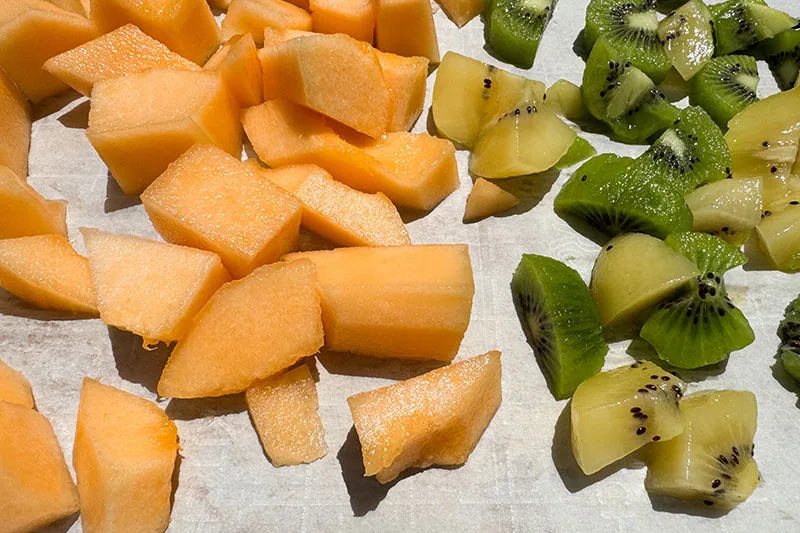
When you are ready to make your smoothie bowl, I prep all my toppings. I like to chop up fresh hami melon and both sungold and green kiwi. I also sprinkle this bowl with unsweetened coconut flakes and chia seeds.
Nuts and berries would also work as toppings. Because this has such a tropical feel, I’ll garnish with edible flowers, and/or fresh mint too. Have everything ready so when you blend your fruit in the blender, you can just pour into a shallow bowl and add your toppings.
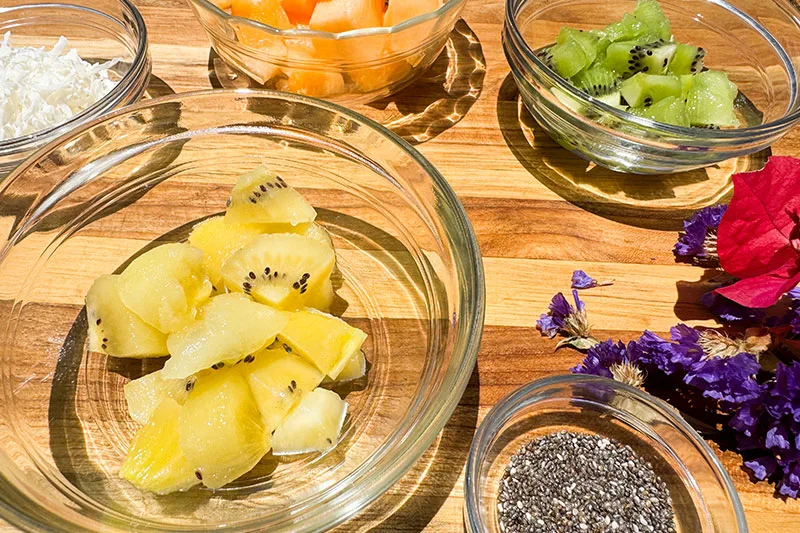
In a blender, and the frozen fruit, coconut water or plain water (or a mixture of both) and the mint and blend. Depending on how much frozen fruit I add, sometimes I need more water. I used coconut water here to emphasize the coconut shavings I put on top but regular water works just fine…or a mix of waters like I used. Scrape down the sides with a spatula as needed, and add more water as needed to get a slushy consistency. I tend to like mine thicker so I’m eating it with a spoon and lots of toppings like a meal. Honestly, this is so good that it is a delicious dessert idea in the summer too.
Pour into the bowl, add your toppings and garnish with flowers and/or mint if you are using. Grab a spoon and dig in. Did you like this recipe? If so, please rate the recipe below and leave a comment. Looking for other frozen dessert ideas? Try these:
Cherry, Acai, Pomegranate & Raspberry Smoothie Bowl
Sugar Free Chocolate Protein Truffles
Chocolate Dipped Yogurt & Berry Bites
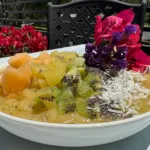
Hami Melon and Kiwi Smoothie Bowl
Nutritional information is only an estimate. The accuracy of the nutritional information for any recipe on this site is not guaranteed.
Ingredients
- 2 Cups Frozen hami melon chunks
- ½ Cup Fresh hami melon, chopped
- 1 Cup Frozen kiwi chunks, green & golden mixed
- 1 Fresh, ripe kiwi, chopped
- 4-6 Tbsp. Coconut Water (or plain water)
- 1 – 2 Tsp. Lakanto or Swerve sugar substitute, optional
- 1 Tbsp. Fresh mint leaves
- 2 Tsp. Unsweetened coconut flakes
- 1 Tsp. Chia seed
- Edible flowers and/or fresh mit for garnish (optional)
Instructions
- Place the frozen kiwi and hami melon chunks in a blender or food processor with the water, sweetener and mint leaves. Process until smooth. Add a little more coconut water or plain water if needed. Scrape down the sides of the bowl as needed. Pour into two bowls.
- Top with the seed mixture, coconut flakes and fresh diced fruit. Garnish with edible flowers (if using). Enjoy!






